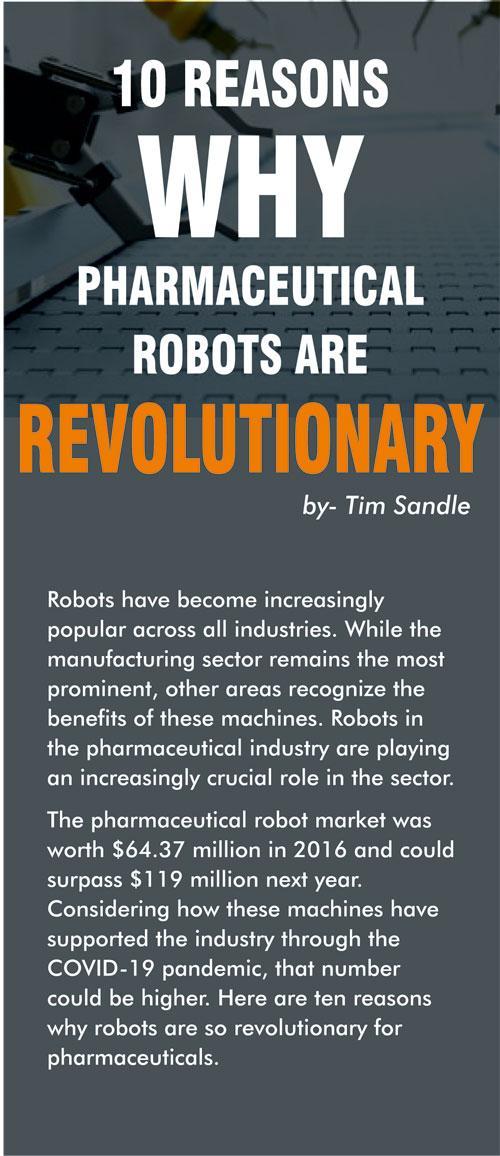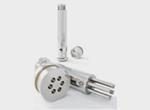 1. They Accelerate the Drug Discovery Process
1. They Accelerate the Drug Discovery Process
While the word “robot” conjures up images of physical machines, not all robotics look like that, some of the most promising pharmaceutical robots are software bots, which automate digital processes. Perhaps the most significant application for these bots is in drug discovery.
Finding new drugs is typically an expensive, laborious process, but automation accelerates it. AI-based programs can discover possible treatments within weeks instead of months. This kind of speed would lead to the quicker treatment of novel diseases and reduced prices.
2. They Increase Operational Capacity
In any sector, organizations can face throughput limitations as a result of a diminished workforce. In pharmaceuticals, this limited capacity can be dangerous, as many people need medicine to survive. Collaborative pharmaceutical robots (Cobot) can help companies increase their output without needing more workers.
These ‘cobots’ can assist human workers by automating simpler tasks, helping employees achieve more in less time. Pharmaceutical organizations can then produce more drugs, fulfill additional orders, or process a higher number of customers without hiring more people.
3. They are More Precise Than Humans
Speed and cost efficiency are not the only areas in which robots tend to outdo humans. Robotic systems are typically more precise than human hands, which is crucial for scientific industries like pharmaceuticals. It enables them to perform delicate work with a consistent level of quality.
People get bored and tired after hours of work, which can jeopardize their precision. In pharmaceuticals, where exact measurements are essential, that can be dangerous. Machines do not have this problem, making robots in the pharmaceutical industry an indispensable resource.
4. They Excel at Repetitive Tasks
The pharmaceutical sector involves a lot of repetitive tasks, like filling bottles and moving products. These can take time away from more urgent work but are still necessary. Thankfully, repetitive work happens to be where robots shine the brightest.
Robots can handle these jobs, so humans do not have to, and they can do them faster. Some pharmaceutical robots can place products at speeds of 400 parts per minute or more.
5. They Reduce Contamination Risks
The US FDA recalls roughly 4,500 drugs and devices a year, and contamination accounts for many of them. It can come from many places, especially if the drug manufacturing process involves multiple people. Robots can minimize these risks.
With fewer people involved, the likelihood of cross-contamination drops. Similarly, cleaning robots can ensure all rooms and equipment are sterile. Pharmaceutical companies can then avoid contamination, which can be both costly and dangerous.
6. They Fill Labour Shortages
The private sector faces a STEM worker shortage despite degree achievement reaching record highs. Many people with science degrees pursue a career in research, leaving pharmaceutical companies in need of workers. Robots in the pharmaceutical industry can meet this demand.
While robots cannot automate all tasks, they can fill many of them. By automating part of the workforce, the sector can continue to meet demand with fewer employees.
7. They Improve Pharmacovigilance
Pharmacovigilance, ensuring pharmaceuticals meet regulatory standards, is essential for the industry. Unfortunately, quality inspections can be repetitive and dull, leading to tiredness in humans and increasing the likelihood of a mistake.
Collaborative pharmaceutical robots are ideal for this work, as they excel in rule-heavy, repetitive tasks. Humans may still need to perform final inspections, but cobots accelerate the process and improve its accuracy. The industry can then become safer and more efficient.
8. They Secure Material Handling
Many pharmaceutical products involve sensitive materials. As such, moving and storing these resources can be a delicate task. Robots, with their superior precision and sturdiness, are ideal for managing these jobs.
Engineers can design robots, so they can’t move too quickly or violently and endanger sensitive materials. Companies can then apply robotics to move items rapidly and safely. This advantage would minimize loss and maximize efficiency.
9. They Improve Worker Safety Amid Health Crises
Robots across many industries owe their recent growth to the COVID-19 pandemic. Amid these heightened health concerns, companies have had to keep employees physically distant to avoid spreading the virus. Collaborative pharmaceutical robots have played a key role in doing just that.
The US CDC recommends maintaining a 6-foot distance between workers. Cobots can work in the spaces between employees, helping them adhere to these guidelines. Automating some processes also reduces the number of people in a building at once, preventing infections and cross-contamination.
10. They Can Analyse Data Faster and More Accurately
Robotic process automation (RPA) handles data-heavy digital work so humans can focus on other tasks. One of the most useful applications of RPA is data analytics, which can reveal workplace inefficiencies or ways to improve. Pharmaceutical companies can then use these analytics to reduce costs, increase safety, and meet regulatory guidelines.
Human workers can analyse this data too, but not as fast or as thoroughly. RPA can quickly find connections between data points that humans may miss. The resulting insights provide pharmaceutical companies with an exact way forward.

Pharmaceutical Robots Are the Future of the Industry.
Robots in the pharmaceutical industry are still a relatively new phenomenon. As robotics adoption in the sector increases, it becomes evident that these technologies will be standard before long. Robots are changing the sector for the better.









